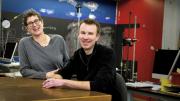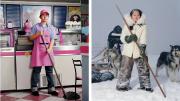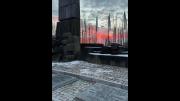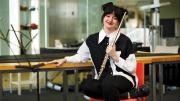Walls covered with blackboard paint and tables on wheels fill one of Harvard’s more unusual new classrooms; hammers and screwdrivers hang from a tool board attached to a half-painted wall. “We want this space to feel like a workshop or a garage,” says Logan McCarty, director of physical sciences education and one of the instructors who designed the new space. “If students are doing a lab, and they have to bolt something to the wall, or hang something from the ceiling, they can do it.”
The SciBox, as its creators named the sprawling, 2,500-square-foot-space, is the stage for a few of the diverse new pedagogical experiments exploring the possibilities of experiential education—part of Harvard’s broader interest in testing new ways of teaching and learning. Though the edX online learning partnership with MIT has attracted the lion’s share of attention and institutional support, experiential education—sometimes referred to as hands-on learning—also plays a role in this University priority, inaugurated in 2011 with the Harvard Initiative for Learning and Teaching (HILT), and now a theme of the capital campaign.
“Experiential learning is participative—for example, either making or doing,” explains Erin Driver-Linn, associate provost for institutional research and HILT’s director. “What do we need to understand, as learners, that is conceptual? And what do we need to understand by experiencing things in a different way?”
Because the definitions of “making” and “doing” vary widely by discipline, experiential education has taken diverse forms, under similarly diverse auspices, across Harvard. As part of the Prison Studies Project, for instance, students learn about criminal justice alongside prison inmates. In a class on African-American popular music, guest workshops funded by the Elson Family Arts Initiative teach students to sing and dance in the style of Motown and funk.
The more experimental atmosphere of the SciBox (funded by HILT and located in the Science Center, the locus of much undergraduate science teaching) reflects a departure from the traditional physics-lab curriculum. “Just going through this process of making [the new space] makes you ask a lot of questions about how we teach and about what other possibilities there are,” explains Melissa Franklin, Mallinckrodt professor of physics and the other SciBox designer, in a HILT video describing the space. Rather than performing different “canned” experiments each week, small groups of students now tackle more complex, open-ended projects; for instance, they might build models and apparatuses to investigate why the weight on a pulley swings side-to-side rather than up-and-down when the string is tugged at a certain frequency. “Each group of students might be doing a single experiment over the course of three weeks, with different students working on different parts,” explains McCarty. “We found that in our old spaces, it was hard to do that.”
In the introductory course “Stellar and Planetary Astronomy,” the more mobile, informal setting of the SciBox—inspired by the concept of a black-box theater—has enabled professor of astronomy John Johnson (see Harvard Portrait, January-February, page 23) to implement a “flipped” classroom approach. Students learn by doing problems, spending most of each class session working in small groups at the “blackboard” walls. Their weekly homework, meanwhile, is to write five publicly accessible blog posts—some must describe problem solutions, others communicate astronomical news. Meanwhile, Johnson and his teaching fellows roam the classroom, occasionally pulling students aside for short, one-on-one oral quizzes (for instance: “Given star x and its celestial coordinates, will it be visible from Cambridge tonight?”), and giving guidance only where necessary. “We’re not allowed to give out answers, we only ask questions,” he says. “We’re here to facilitate learning.”
Such side-by-side problem-solving is the norm at the School of Engineering and Applied Sciences (SEAS), where approximately one-third of engineering courses include an experiential component. In “Engineering Problem Solving and Design Project,” the approximate equivalent of a junior tutorial, students act like management consultants, taking on real-world puzzles with no clear solution or even problem definition; similarly, in “Medical Device Design,” a physician might ask how to improve a clumsy surgical tool—leaving students to formulate the problem in engineering terms and design possible solutions. Faculty members act more like coaches than traditional instructors—in many cases, they do not have the answers, either. “That, of course, is real life,” says SEAS dean Cherry Murray. “Engineers never have a rote situation that’s really trivial and just involves applying an equation.”
One year, students were instructed to help Massachusetts law-enforcement officers find new ways to deal with a gang problem. “Students spent numerous hours with the Springfield police, following them around, being able to be in helicopters over Springfield—actually experiencing what the police were experiencing,” says Murray. Through an iterative process, they worked with the police to define problems and design potential solutions—for instance, a software platform that used police data to map and analyze crime—and gained new skills along the way. “It’s very important,” says Murray, “that you have the confidence to address problems and not be afraid that you don’t have the background.” A major goal of the SEAS campaign is to fund more such hands-on experiences, she says, and to create “design studios” with equipment and space for students to take on larger projects like building robots and cars. An SEAS faculty committee advising on the design of the school’s new quarters in Allston focused at length on the reconceived teaching spaces required to support this kind of learning (see https://harvardmagazine.com/2014/02/envisioning-science-and-engineering-in-allston).
In the humanities, new spaces are allowing students to participate in art-making practices. Some artistic applications are coincidental—last year, the SciBox hosted a dramatic production—while others are more deliberate. In the HILT-funded Sound Lab, for instance, students have access to equipment and software for composing, recording, and editing music. In “The Art of Listening,” one of three new introductory courses in the humanities (see “Toward Cultural Citizenship,” page 35), students use this equipment to create mix tapes and soundscapes that explore the possibilities of everyday sounds.
“If you work with sounds yourself, if you learn what it is to use digital sound-editing software, you necessarily have to understand how a sound works,” says Peabody professor of music Alexander Rehding, who co-teaches that course. “I could explain it all theoretically, and all that is good up to a point, but if you work with a digital version of a sound wave, you have to engage with it in very practical ways. I see it as complementary.” The experiential component in fact underscores the importance of the humanities; in Rehding’s words, “We’re engaging with the humanities all the time, even when we don’t know it.”
Sometimes, the engagement is deeply personal. In the HILT-funded course “Quests for Wisdom: Religious, Moral, and Aesthetic Searches for the Art of Living,” offered for the first time last fall, Rabb professor of anthropology Arthur Kleinman and Rudenstine professor for the study of Latin America David Carrasco interwove philosophical and religious texts with stories from their academic work and personal lives. Kleinman (who is also professor of medical anthropology and professor of psychiatry) spoke movingly about finding wisdom in caregiving during his wife’s decline and death from Alzheimer’s disease (see “On Caregiving,” July-August 2010, page 25). “The academic and the existential should be mixed,” says Carrasco. In the context of students’ personal quests for wisdom, thinkers like William James and Toni Morrison became dialogue partners and interlocutors—as Carrasco describes it: “someone who was not just a theoretician or a novelist, but someone who was a life.”
The quest expanded beyond philosophy into anthropology, religious studies, and the arts. Through excursions and guest workshops, students learned modern dance, listened to jazz, contributed art to the Day of the Dead altar at the Peabody Museum, and developed and performed a play after spending time with Holocaust survivor Judith Sherman and reading her memoir, Say the Name: A Survivor’s Tale in Prose and Poetry. “Arthur and I were profoundly moved by the intensity and depth of the students’ responses,” says Carrasco; he and Kleinman have asked their students to stay in touch for the next five years. “We care for these students,” Carrasco says. “We think this is one of the ways to awaken in them the potential not just for a career, but for a meaningful life.”
At the same time, Carrasco offers some cautions about experiential education: “Partly because students are sitting on their behinds for hours, experiential learning sounds like stretching.” But experiences gain their value in combination with intellectual discipline, he says; in “Quests for Wisdom,” students assessed the readings and media they encountered through frequent analytical writing assignments and a final project. Carrasco also takes care to emphasize the value of more traditional forms of experience. “I might want to go to [Friedrich] Schleiermacher’s hometown and look at the environment in which he preached and thought—and that’s good,” he says, referring to the German theologian and philosopher. “But you can read Schleiermacher and have a profound, insightful experience. You just have to know how to do it.”






